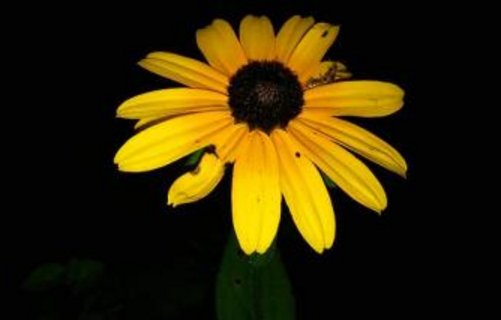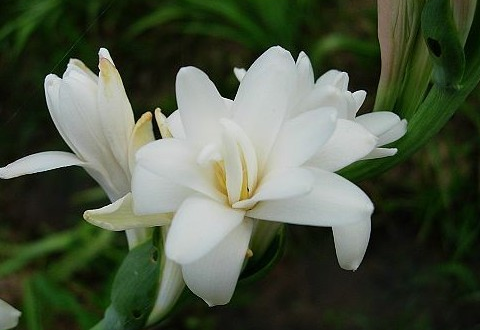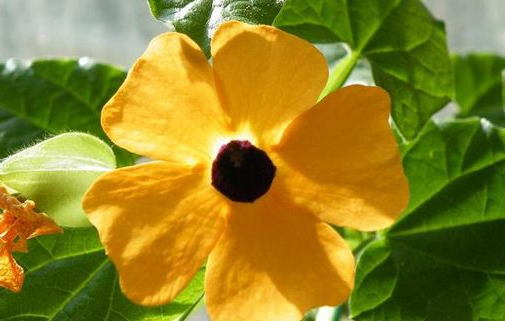Sowing and propagation of black-eyed Susan
The tools needed
Flowerpots, pots of soil, shovels, seeds, sprinklers and so on are needed for sowing and reproduction.
Preparatory work
The first thing seeds should do before sowing and reproduction is to select seeds, choose healthy black-eyed Susan seeds, and save them after drying, so as to prevent seeds from germinating and mildew, causing plants not to germinate and cannot be planted well.

Matrix
Good nutritious matrix, it is best to choose sand and gravel, etc., is more conducive to plant air permeability, water permeability is also better, and contains the matrix of decaying matter.
The steps of reproduction
Place the prepared substrate in the flowerpot, loosen the pot soil with a shovel, sow the prepared seeds evenly on the basin soil, cover it with a little soil, water it with a kettle, be careful not to sprinkle too hard, sprinkle it gently, and be careful not to wash the seeds out. Finally, don't forget to fertilize and cover the flowerpot with a sunshade net so that the plants can grow better.
Maintenance after sowing
Black-eyed Susan likes fertilizer, and once planted, she should be often watered and fertilized from spring to autumn in order to keep blooming. The basin soil should use nutrient-rich culture soil, and nitrogen, phosphorus and potassium compound fertilizer can also be used as base fertilizer, and liquid fertilizer should be continuously replenished in the process of cultivation. It will be more suitable to irrigate pollution-free cultivation nutrient solution regularly. Black-eyed Susan has golden colors, such as potted plants, climbing windowsills or small flower sheds.
Sowing and propagation of black-eyed Susan
The breeding method of Black-eyed Susan
Black-eyed Susan has two methods of reproduction: cutting propagation and sowing reproduction.
The tools needed for sowing and reproduction of black-eyed Susan
Flowerpots, pots of soil, shovels, seeds, sprinklers and so on are needed for sowing and reproduction.
Seed preparation for reproduction of black-eyed Susan
Before sowing and reproduction, the first thing we should do is to select seeds, choose healthy black-eyed Susan seeds, and save them after drying, so as to prevent the seeds from germinating and mildew, causing the plants not to germinate and unable to plant well.
Basin soil
To prepare a good nutritious matrix, it is best to choose sand and gravel, which is more conducive to the air permeability of plants, water permeability is also better, and contains the matrix of decaying matter.
The steps of sowing and reproduction of black-eyed Susan
Place the prepared substrate in the flowerpot, loosen the pot soil with a shovel, sow the prepared seeds evenly on the basin soil, cover it with a little soil, water it with a kettle, be careful not to sprinkle too hard, sprinkle it gently, and be careful not to wash the seeds out. Finally, don't forget to fertilize and cover the flowerpot with a sunshade net so that the plants can grow better.
Black-eyed Susan sowing method Black-eyed Susan how to sow Black-eyed Susan is a perennial vine, can be cultivated annually, petiole winged, sparsely pilose. Leaf blade ovate-Sagittate or ovate-slightly halberd, apex acute, base arrowhead or slightly hastate, margin shortly dentate or entire. Flowers solitary leaf axils, tube-shaped bell-shaped, Corolla 5-lobed, eaves yellow or yellowish, throat purple-black. Capsule. Flowering the Summer Solstice autumn. It usually uses sowing and cutting propagation, today the editor mainly tells you about its sowing knowledge. Black-eyed Susan sowing is usually carried out in spring, if there are conditions, you can also advance some time, mainly to ensure that the temperature of germination is about 20 ℃, but autumn sowing is not recommended, because black-eyed Susan is not too cold-resistant, there is no warm measures, sowing will only waste seeds. In fact, the difficulty of sowing black-eyed Susan is moderate, and it is not very difficult. Here are not one by one explanation of each step. Here are several more important parameters of sowing for flower friends' reference, sowing temperature and whether to cover soil: 21-24 ℃, soaking seeds for one night, can make germination faster. In the use of very low soluble salt levels and pH: 5.5 Mel 6.2. Medium. Do not need light, cover the soil. Cover the seeds with vermiculite. Keep the medium moist. Avoid direct sunlight. In addition, black-eyed Susan is a vine, which can climb up to 3 meters. It takes about 2 months from sowing to flowering, germination temperature is more than 20 ℃, germination time is 6-12 days, and it can blossom in the same year. Black-eyed Susan likes fertilizer, and once planted, she should be often watered and fertilized from spring to autumn in order to keep blooming. The basin soil should use nutrient-rich culture soil, and nitrogen, phosphorus and potassium compound fertilizer can also be used as base fertilizer, and liquid fertilizer should be continuously replenished in the process of cultivation. It will be more suitable to irrigate pollution-free cultivation nutrient solution regularly. Plants are often sprayed with water at the height of summer to improve environmental humidity. Black-eyed Susan needs full sun or slight shade, preferring warmth. The medium can be mixed with 2 parts of peat, 2 parts of rotten leaf soil and 1 part of perlite or river sand. It is less tolerant to drought, quantitative watering is beneficial to growth, and pruning from time to time can make the plant grow more luxuriantly and promote flowering. Note: black-eyed Susan is easy to grow worms. When the weather is warm, there will be red spiders. Conclusion: the above is the knowledge about black-eyed Susan sowing. I hope you can have a deeper understanding of black-eyed Susan planting.
- Prev

Culture method of tuberose
1. The soil tuberose is not strict with the soil, likes fertile clay soil, and cannot accumulate water, and is not suitable for growing in sandy soil. 2. Light tuberose like sufficient light, need regular ventilation, summer in the balcony, courtyard care, ensure sufficient sunshine. 3. Temperatures tuberose loves warm environments
- Next

How does black-eyed Susan raise it?
The environment likes the warm and humid environment, and likes the sunny environment, the best growth temperature is 20-30 degrees Celsius, not hardy, once the temperature is below 8 degrees Celsius, it is difficult to maintain its normal growth. Fertilizer plants that like fertilizer very much, once they begin to grow, they should carry out fertilization strictly.
Related
- Fuxing push coffee new agricultural production and marketing class: lack of small-scale processing plants
- Jujube rice field leisure farm deep ploughing Yilan for five years to create a space for organic food and play
- Nongyu Farm-A trial of organic papaya for brave women with advanced technology
- Four points for attention in the prevention and control of diseases and insect pests of edible fungi
- How to add nutrient solution to Edible Fungi
- Is there any good way to control edible fungus mites?
- Open Inoculation Technology of Edible Fungi
- Is there any clever way to use fertilizer for edible fungus in winter?
- What agents are used to kill the pathogens of edible fungi in the mushroom shed?
- Rapid drying of Edible Fungi

